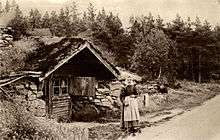Backstuga

A Backstuga (Literary: "hill cottage") was a form of residence previously used in Sweden. It was a small, simple cottage, inhabited by non-farming people. The cottages were normally (but not always) built on the village common land, specifically on land which was useless for farming. This was normally a hillside, where the cottages were built quite low in the ground, and one of the four walls in the single room of the cottage was actually the bare earth wall of the hill, hence the name backstuga meaning hill cottage. Though this was the most common structure, there were some variations: sometimes, for example, the cottage was built with four walls of wood, but stretched halfway down into the ground, and then sometimes referred to as jordstuga (earth cottage).[1]
The phenomenon is known from at least the early 17th century until the 19th century. The backstuga were inhabited by those of the peasantry not active in the productive life of the community, such as old people who could no longer work, retired servants and the community destitute who had no relatives to care for them but were not placed in the poor house or left for the rotegång. These were called backstugusittare (hill cottage sitters).
Hill cottages were the common residence for the village community destitute in most parts of Sweden.
See also
References
- ↑ Erixon, Sigurd Emanuel; Ericson, Olof (1960). Sveriges bebyggelse: svensk statistisk-topografisk uppslagsbok. Landsbygden. Kronobergs län. Hermes.
Other sources
- Svensk uppslagsbok
- Nils-Arvid Bringéus: Arbete och redskap kap. 11. Byggnadsskick